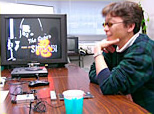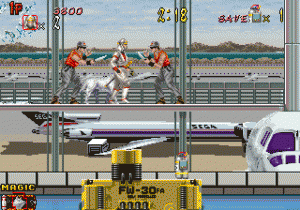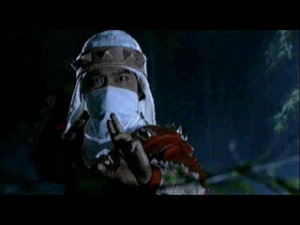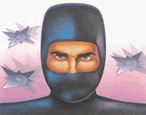Shinobi in Japanese means: stealing (into); spy; sneak thief; surreptitious visit to house of ill repute.
They are invisible and deadly, taking on the most dangerous of missions without even a second thought. They are ninja, mysterious servants of death and subtlety and you will never see them coming…
…unless they wear pink, yellow, or bright red like in those tacky ninja movies of the 80s.
Yes, Americans have taken a collective dump on what were once considered the most deadly warriors around. Ninjas were everywhere in the 1980s and video games were no exception. In truth, one of the only really good things to come out of that decade, ninja-wise, was the creation of one of the best action series ever made.
Making its debut in 1987, the original Shinobi was a huge hit. Gamers loved the ninja star-tossing, sword-slashing, ninjutsu powers of Joe Musashi; pumping quarters into it at a furious pace. The game took advantage of the “ninja fever” that swept the U.S. in the ’80s and set arcades ablaze. Many sequels followed but Musashi disappeared after Shinobi Legions on the Saturn, a game that most fans labeled as the series’ swan song.
Not so!
Shinobi has recently been given a new lease on life with releases on the Playstation 2 and Game Boy Advance. Moreover, Overworks has said that a direct sequel to the PS2 hit is in the works (after Nightshade). Hopefully, this signifies the resurgence of everyone’s favorite ninja and many more games in the future.
Since 1987, the thirteen titles in the series have provided gamers with hours of fun and excitement, leaving them eager for the next installment. On the Sega Genesis, Joe had a total of three adventures, which rank among the best in the series. While it’s fun to contemplate the future, it’s also important to review Shinobi‘s past outings. There are far too many gamers out there that have never played any of the older titles and they’re missing out on some of the greatest action games ever made.
Developer History
Shinobi was designed by  , who joined Sega in 1987 as a planner. There he worked on such hits as Wonder Boy in Monster Land. Becoming a member of Sega’s consumer R&D department, he eventually became the head of the group when it transformed into Overworks, an internal design studios at Sega in 2001. Overworks is well known for its work on the Sakura Taisen series and the great Dreamcast and GameCube RPG Skies of Arcadia. In addition to his famous ninja creation, Ohba (and co-designer Takashi Uriu) is also credited for having worked on Streets of Rage. It is for the adventures of Joe Musashi, however, that gamers know him best.
, who joined Sega in 1987 as a planner. There he worked on such hits as Wonder Boy in Monster Land. Becoming a member of Sega’s consumer R&D department, he eventually became the head of the group when it transformed into Overworks, an internal design studios at Sega in 2001. Overworks is well known for its work on the Sakura Taisen series and the great Dreamcast and GameCube RPG Skies of Arcadia. In addition to his famous ninja creation, Ohba (and co-designer Takashi Uriu) is also credited for having worked on Streets of Rage. It is for the adventures of Joe Musashi, however, that gamers know him best.
The Games
The first outing for Joe Musashi, Shinobi was a smashing success in arcades. It combined platforming with straight-up action and was very easy to learn but extremely difficult to master. Running on Sega’s powerful System-16 hardware (the same that ran Fantasy Zone and Golden Axe) and sporting top-notch graphics and sound, the game followed Mushashi as he attempted to rescue the children of the world’s leaders held captive by the powerful crime syndicate Ring of Five. Joe could use shurikens in addition to his powerful sword and kicks and it was here that we were first introduced to Ninjutsu, or ninja magic. Able to take out even the most powerful enemies, Joe’s ninja magic would become a permanent fixture in the series and one of his most recognizable attributes.
Joe was a pretty agile guy (he’s a ninja, duh!) and had many moves at his disposal. He could jump over fences and up to higher floors, crouch and move, and jump and shoot simultaneously. This may not seem like much today, but back when the game came out it was a pretty new thing to see a character with so many moves. Through a total of five rounds, which were longer than one might think, the player had to battle all kinds of evil ninjas, massive samurai warriors, even a helicopter! There were bonus stages after each boss level which added to the already varied gameplay, and they were very well crafted and a load of fun to boot. Truly one of the classic arcade titles out there, it behooves gamers to find a version and give it some decent play time. I prefer the Master System game, though I’ve never played the PC-Engine version. Rumors have recently about the game coming to Xbox Live Arcade for 400 MS points, but nothing has been confirmed. It seems unlikely though, as there hasn’t been a new XBLA release at that price point for quite some time, and Microsoft seems to have put arcade ports behind it.
Every hit game needs a sequel, and Shinobi was no exception. The Revenge of Shinobi was a Genesis launch title and was both highly praised and successful. It differed slightly from the original in that there were no longer children to save but the basic game play formula remained intact. Musashi still used his shurikens to rain metal death upon his foes and he still had NBA-level jumping skills. What was new to the series was the ability to choose from set of ninja magics, each with its own specific trait. Some were offensive, some were defensive, and some enhanced Musashi’s already incredible abilities even further.
The game’s eight rounds were beautifully drawn, with spanning parallax and highly detailed sprites (check out Joe’s knee pads!). The tight gameplay and awesome graphics were perfectly complimented by one of the greatest soundtracks in gaming. Maestro Yuzo Koshiro provided a selection of tunes that fit each stage to a tee and caused many a gamer to scramble for a way to record them to cassette (way back before MP3s!). This was the definitive title to buy when you got the system and one that would turn NES owners (and Genesis naysayers) green with envy. It was simply a wonderful game in all ways.
A fun note is that original versions of the game (those with the copyright on the title screen) featured both Spider-Man and Godzilla as bosses. A Batman-like foe was also included but all three were taken out in later versions due to licensing problems.
Revenge received a direct sequel on the Genesis with Shinobi III: Return of the Ninja Master. Considered by most gamers to be the pinnacle of the series in 2D, Shinobi III perfected all the elements seen in the first two games and added immensely improved graphics and effects. The sound may not be up to the standard set by Revenge‘s legendary musical score but it’s definitely nothing to scoff at. Everything was top notch and the gameplay had been refined even more (double jumps weren’t so spotty this time).
Return of the Ninja Master set the stage against the Neo Zeed organization yet again (it’s hard to keep an evil ninja down!). This time they were being run by Shadow Master, an evil ninja cloned from Joe Musashi himself. Having no other choice, Joe tackled his nemesis and eliminated the Zeed syndicate once and for all (or so he thought).
 Back in 1989, arcades were still pretty popular and Musashi would make one more appearance there. The second Shinobi title released in coin-op form, Shadow Dancer went back to the style of the first game, requiring you to rescue or retrieve something to pass the level. In this case, you had to find all the weapons from the Olympia shuttle mission, which were taken when the terrorist group “Asian Dawn” hijacked the craft. Mushashi, accompanied now by his faithful dog, must use all his famous powers to take down Asian Dawn. While Shadow Dancer for the most part played similarly to it’s coin-op older brother, the inclusion of the dog added a bit of variation into the mix. Don’t want to risk rushing that soldier before he can fire? Send out your dog! There weren’t too many parts of the game where he was particularly useful but it was cool to see a ninja and his big wolf-dog kicking ass.
Back in 1989, arcades were still pretty popular and Musashi would make one more appearance there. The second Shinobi title released in coin-op form, Shadow Dancer went back to the style of the first game, requiring you to rescue or retrieve something to pass the level. In this case, you had to find all the weapons from the Olympia shuttle mission, which were taken when the terrorist group “Asian Dawn” hijacked the craft. Mushashi, accompanied now by his faithful dog, must use all his famous powers to take down Asian Dawn. While Shadow Dancer for the most part played similarly to it’s coin-op older brother, the inclusion of the dog added a bit of variation into the mix. Don’t want to risk rushing that soldier before he can fire? Send out your dog! There weren’t too many parts of the game where he was particularly useful but it was cool to see a ninja and his big wolf-dog kicking ass.
There were four rounds, each composed of multiple stages, and varying in style. Airports, train stations, caves, even the sewers were battlegrounds. The graphics were a step up over the first game and Sega put its System 18 board to great use. The game was ported to a number of systems, including the Master System, Amiga, and Commodore 64; though the Amiga port was probably the closest graphics-wise and had most of the levels. Some enhancements to the series made in Revenge were incorporated here. For example, retrieving a few of the stolen armaments earned you a POW that raised your attack power. They unfortunately went back to the single ninja magic, which was a step down, in my opinion. The Genesis port was almost a totally different game which some would argue was even better than the arcade original. The dog was present but most everything else, including Joe’s very sprite, had been changed (the terrorists were now called “Union Lizard”). Moreover, the game isn’t a direct sequel to Revenge of Shinobi and is considered more of a side story.
Even though Musashi was tearing up the Genesis, the ol’ Master System still had a bit of life in it back in 1990 and Sega decided to release a few new Shinobi games for it. In The Cyber Shinobi, you played Joe Musashi’s grandson who had to take down “Cyber Zeed,” which had been resurrected and was stealing plutonium from the world’s power plants.
Joe ditched his pooch and went back to his lonesome ways here. His ninjutsu could now be upgraded and used a certain levels (like the magic in Golden Axe). While not in the same league as its Genesis sibling, Cyber Shinobi did have some decent graphics. The Master System was capable of putting out a respectable amount of colors and quite a bit of it was used here. Sprites were also large and reminiscent of the original game (the whole game seemed to try to emulate the original in style) and did manage to convey the whole “Shinobi sense” of the series. Not everything was pleasant though. The control was a bit sluggish, the jumping was off, and there were no shurikens! Supposedly, this was one of the rarer games in the series (it was only released in Europe) and doesn’t pop up on eBay too often.
Alex Kidd in the Shinobi World saw Sega’s failed mascot try yet again to make himself wanted. This time, he’s possessed by a god to battle the Dark Ninja, who has returned to Miracle World and taken his girlfriend prisoner. As he battles through several worlds, Alex can break open treasure chests to obtain life power ups, weapons, or even a tornado icon which is like a special magic that obliterates everything on-screen.
As far as Alex Kidd games go, Shinobi World was one of the better releases. It actually wasn’t a bad ninja title either.
With all these different titles being released, the Game Gear was next in line to get its fair share of ninja action. It got two games, which was a pretty good feat considering the checkered history of Sega’s ill-fated handheld. Putting you in Musashi’s shoes once more, the portable Shinobi games brought something new and innovative to the series in letting you choose the order in which you tackled the levels (the first four, at least) a la Mega Man. A bit of strategy is needed here because as you finish the stages, you rescue other ninjas; giving you new weapons, magic, and skills to apply. Certain power ups can only be applied to specific ninjas, which can be chosen at any time via the pause menu. The second game continued this dynamic and went further by allowing you to reenter stages to find special crystals needed to enter the final labyrinth. Both games are infamous for their brutal difficulty and Yuzo Koshiro tunes (headphones, anyone?) and need to be re-released now!
In 1995, the Genesis was in its twilight and the Saturn became Sega’s focus. Having too much on their plate, Sega gave the rights to a new game to Vic Tokai, who released Shin Shinobi Den (Shinobi Legions in the U.S.). Although it continued the 2D action gameplay of the the other games, Legions stepped into the next generation by incorporating digitized graphics and full motion video cut scenes. The FMV scenes may have been laughably cheesy but the digitized graphics worked really well. Many Shinobi purists disliked, even hated, the new style but I think it was time for something new without breaking the successful formula established by the series over so much time.
 Again, Joe is not the main character. Instead, you play Sho, who is trying to rescue his sister Aya from their deranged brother Kazuma. It sounds a bit like a Mexican soap opera and is just about as corny (again, those hilariously bad cut scenes!). What relation Sho and his clan have to Musashi, if any, is unknown but the game is still a great play.
Again, Joe is not the main character. Instead, you play Sho, who is trying to rescue his sister Aya from their deranged brother Kazuma. It sounds a bit like a Mexican soap opera and is just about as corny (again, those hilariously bad cut scenes!). What relation Sho and his clan have to Musashi, if any, is unknown but the game is still a great play.
The series lay dormant for a few years, with no new installments coming out on either the Saturn or Dreamcast. It wasn’t until Sega made the decision to go multi platform in 2001 that Overworks finally began work on the next game. Since the PlayStation 2 was the most successful console of the current generation (and the first one they got tools for), Ohba and Uriu decided to make it the new home for Shinobi. Uriu also had some experience with the system from the Sakura Taisen series, so the choice seemed natural.
The PlayStation revival of Shinobi took the game into 3D for the first time in its history and many fans were understandably apprehensive about the new direction. The gaming obituaries are filled with franchises that were unable to survive the transition and that thought weighed heavily on the minds of Shinobi‘s designers. Again, Musashi was not the main character (though he was unlockable), stepping back to a new breed of ninja by the name of Hotsuma. Instantly recognizable by his flowing red scarf, Hotsuma was out to avenge the destruction of his clan. Dark, brooding graphics and swift-as-lightning gameplay brought the series into the modern era in style and gamers were wowed by the new “tate” (pronounced “tah-tay”) feature, which rewarded you with a mini cut scene whenever you sliced and diced several enemies in succession.
A lock-on feature made it easy to slash through multiple foes and Hotsuma’s sword even grew to love the carnage. At one point in the game it acquires the ability to suck the life from fallen opponents and to make sure Hotsuma tackled them in numbers, the sword slowly ebbed away his own life force if he failed to feed it. In order to reach fresh meat, Hotsuma had all the typical ninja abilities previously seen, with the addition of a Prince of Persia-like wall run (I know PoP came later). The combination of moves and blazing action was matched only by the game’s difficulty. While no Shinobi game was ever necessarily easy, the PS2 sequel added the nuances that go with 3D and the need in some places to chain attacks to cover open pits. Many gamers fell into the abyss enough times to see it stare back.
To continue the revival of the franchise, a version was released on the Game Boy Advance in 2002. 3D6 (the same team responsible for the unexceptional Altered Beast GBA game) handled most of the programming duties, with some input from Overworks. Even with all the expectations a portable Shinobi would have (especially after the two Game Gear installments) it would appear that 3D6 strived to recreate the utter mediocrity that was Altered Beast instead of trying to go for what made the Shinobi games so good in the first place. The newest handheld Shinobi title was a letdown on all fronts, and almost shook the faith of gamers that the series as a whole had spent so long establishing.
I guess you could say that what’s so bad about this game is its utter lack of respect or even acknowledgement of the series for which it is named. The main character is named “Shinobi” for crying out loud. 3D6’s utter lack of ambition is also apparent in the cookie-cutter storyline and generic gameplay. The sluggish control, uninspired level design, and all around laziness of the effort make GBA Shinobi the black sheep of this ninja family.
I’m mostly peeved because Overworks actually supervised this project. They also supervised the Phantasy Star Collection release and that turned out quite well, with the exception of the save bug in the original Phantasy Star. I have no idea what happened with Shinobi. There was simply no excuse for such an important franchise to have been treated so poorly here.
The latest member of the Shinobi mythos, Nightshade, distinguished itself for featuring a female ninja. As Hibana, you battled through twelve stages of action very similar to what was seen in the first PS2 Shinobi. This time around, however, the gameplay had been tweaked and refined (she could now use a very useful jump kick for stringing tates) and the graphics were upgraded. There were still plenty of hidden coins to find and it was still so much fun to tate all those foes together and watch them melt like so much butter before a hot knife.
One thing that was also maintained was the original’s brutal difficulty. Pits were still your worst enemy, as it was quite possible to string a load of tates and get all the secret coins, only to be done in by a single misstep at the level’s end. Zen-like patience or a pillow in the corner (to soften the impact when you threw your controller) were required. Even with the improved lock-on system, it could get frustrating quick.
Ninja Magic for the Future?
 Things look pretty promising for the Shinobi series. The release of games like Ninja Gaiden, Tenchu, and even the return of the Teenage Mutant Ninja Turtles have put the black-garbed warriors back in the limelight. Both Playstation 2 games seem to have sold well enough to warrant future installments and a re-release of some of the classic titles isn’t out totally of the question (Sega Ages?). He might even step out of the shadows onto one of the many downloadable services available. Wherever he chooses to appear, once thing is for certain: the master of Shinobi will make his presence felt.
Things look pretty promising for the Shinobi series. The release of games like Ninja Gaiden, Tenchu, and even the return of the Teenage Mutant Ninja Turtles have put the black-garbed warriors back in the limelight. Both Playstation 2 games seem to have sold well enough to warrant future installments and a re-release of some of the classic titles isn’t out totally of the question (Sega Ages?). He might even step out of the shadows onto one of the many downloadable services available. Wherever he chooses to appear, once thing is for certain: the master of Shinobi will make his presence felt.
The complete release chronology is as follows:
- Shinobi, arcade (1987)
- Shinobi, Sega Master System (1988)
- Shinobi, NES (1989)
- Shinobi, Sinclair Zx Spectrum (1989)
- Shinobi, Commodore 64 (1989)
- Shinobi, Commodore PC (1989)
- Shinobi, Atari ST (1989)
- Shinobi, Amiga (1989)
- Shinobi, DOS PC (1989)
- Shinobi, PC-Engine (1989)
- The Revenge of Shinobi, Genesis (1989)
- Shadow Dancer, arcade (1989)
- Alex Kidd in Shinobi World, Sega Master System (1990)
- The Cyber Shinobi, Sega Master System [Euro] (1990)
- Shadow Dancer, Genesis (1991)
- Shadow Dancer, Sega Master system [Euro] (1991)
- Shadow Dancer, Amiga (1991)
- Shadow Dancer, Atari ST (1991)
- Shadow Dancer, Commodore 64 (1991)
- Shadow Dancer, Sinclair Zx Spectrum (1991)
- Shadow Dancer, Commodore PC (1991)
- Game Gear Shinobi, Game Gear (1991)
- Game Gear Shinobi 2, Game Gear (1992)
- Shinobi III: Return of the Ninja Master , Genesis (1993)
- Shinobi Legions, Saturn (1995)
- Shinobi, PlayStation 2 (2002)
- Revenge of Shinobi, Game Boy Advance (2002)
- Nightshade, PlayStation 2 (2004)
Sources
- Game Info. PHM Shinobi Web Site.
- Interview with Noriyoshi Ohba & Takashi Uriu. Gamepro.com, 5-24-02.
- Interview with Noriyoshi Ohba. Sega Japan Community Album vol.9, 2003.
- Shinobi Game Info. Killer List of Video Games, 1995-2004.

Pingback: Arcade Mania – Shinobi (1987) | Lark's Island